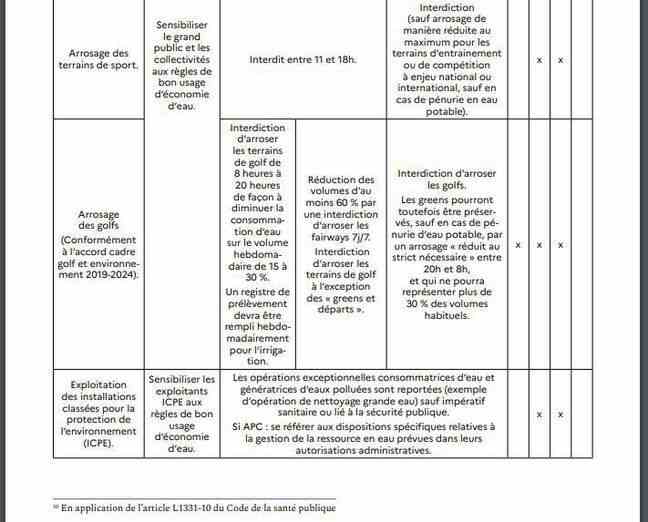Golfers will be able to strike the iron even if it is hot. While the 96 departments of metropolitan France are now affected by the “drought plan” which entails a restriction beyond simple vigilance, many elected officials and Internet users are indignant at a class ecology which would be applied by the government. .
The cause ? While the watering of green spaces is prohibited in the departments on “alert” (yellow level) or that the irrigation of crops is prohibited in departments classified as “crisis” (red level), many Internet users and elected officials point out that golf courses would benefit from an exemption, in the sense of special authorization, allowing them to water their greens, even at the most severe level of drought.
Among them, Eric Piolle, mayor (EELV) of Grenoble, points out that even “when we can no longer water anything, we can still water the golf greens”. An “aberration” for many in view of the 700 pitchesor 33,000 hectares, claimed by the French Golf Federation.
An exception that would favor the rich, reputed to be more often followers than the rest of the population, in view of the costs inherent in the practice of this sport.
FAKE OFF
The Ministry of Ecological Transition published, last June, a implementation guide measures to restrict the use of water in times of drought to guide the departments in the management of water-consuming activities. Irrigation of crops, watering of green spaces, filling of private or public swimming pools, washing of vehicles or facades… Everything is specified there according to the level of alert applied in the departments, from vigilance to crisis. A section is devoted to the watering of golf courses for individuals, businesses and communities.
Small clarification for the uninitiated before detailing these restrictions: The “departure” is a space covered with fairly short grass and with an area of approximately 10 m2, most often raised, from which the first shot is fired. The “green” is the area of short mown grass, more or less circular or sometimes bean-shaped, where the hole is located. Between the two is the “fairway”, a stretch of grass generally measuring between 100 and 500 meters in length.
On “crisis” alert, only the greens can be watered
Thus, if for the “vigilance” level, a simple sensitization is required, the matter thickens for the following levels. At the “alert” level, the guide requires a ban on watering golf courses from 8 a.m. to 8 p.m. in order to reduce water consumption on the weekly volume by 15 to 30%. A sampling register must be completed weekly for irrigation.

For the “enhanced alert” level requires a reduction in volumes of at least 60% by a ban on watering the fairways seven days a week and a ban on watering golf courses with the exception of “greens and tees”. . Finally the maximum level, “crisis”, imposes a ban on watering the golf courses. But the greens can however be preserved, except in the event of a shortage of drinking water by watering reduced to what is strictly necessary between 8 p.m. and 8 a.m. and which cannot represent more than 30% of the usual volumes.
The detractors of these authorizations speak true when they speak of advantages, because at the “crisis” level, many other activities are struck by an outright ban. This is the case for the irrigation of crops, the watering of green spaces and even the watering of sports grounds (with the exception of grounds concerned by competitions with national or international stakes), easily comparable to the golf practice.
A very water-intensive activity
The guide specifies that these authorizations (or prohibitions depending on which side one is on) follow the “Golf and environment 2019-2024” framework agreement signed between the Ministry of Ecological Transition and the federation, aimed at developing sustainable management of water resources, a gradual reduction in the impact on the resource of withdrawals for watering golf courses, a reduction in phytopharmaceuticals and the preservation of biodiversity.
It must be said that hitting the little white ball is a particularly water-intensive activity since a 2003 Senate report estimated the annual consumption of a golf course at 3,800 m3 per hectare. According to our colleagues from Consoglobea route covers an average of 40 hectares, which amounts to the annual water consumption of a town of 7,000 inhabitants.
These authorizations would be justified, according to golf course owners, by the exorbitant cost of the greens. It is the French Office for Biodiversity and its “environment police” which is responsible for the controls. Offenders incur fines of up to 7,500 euros.

